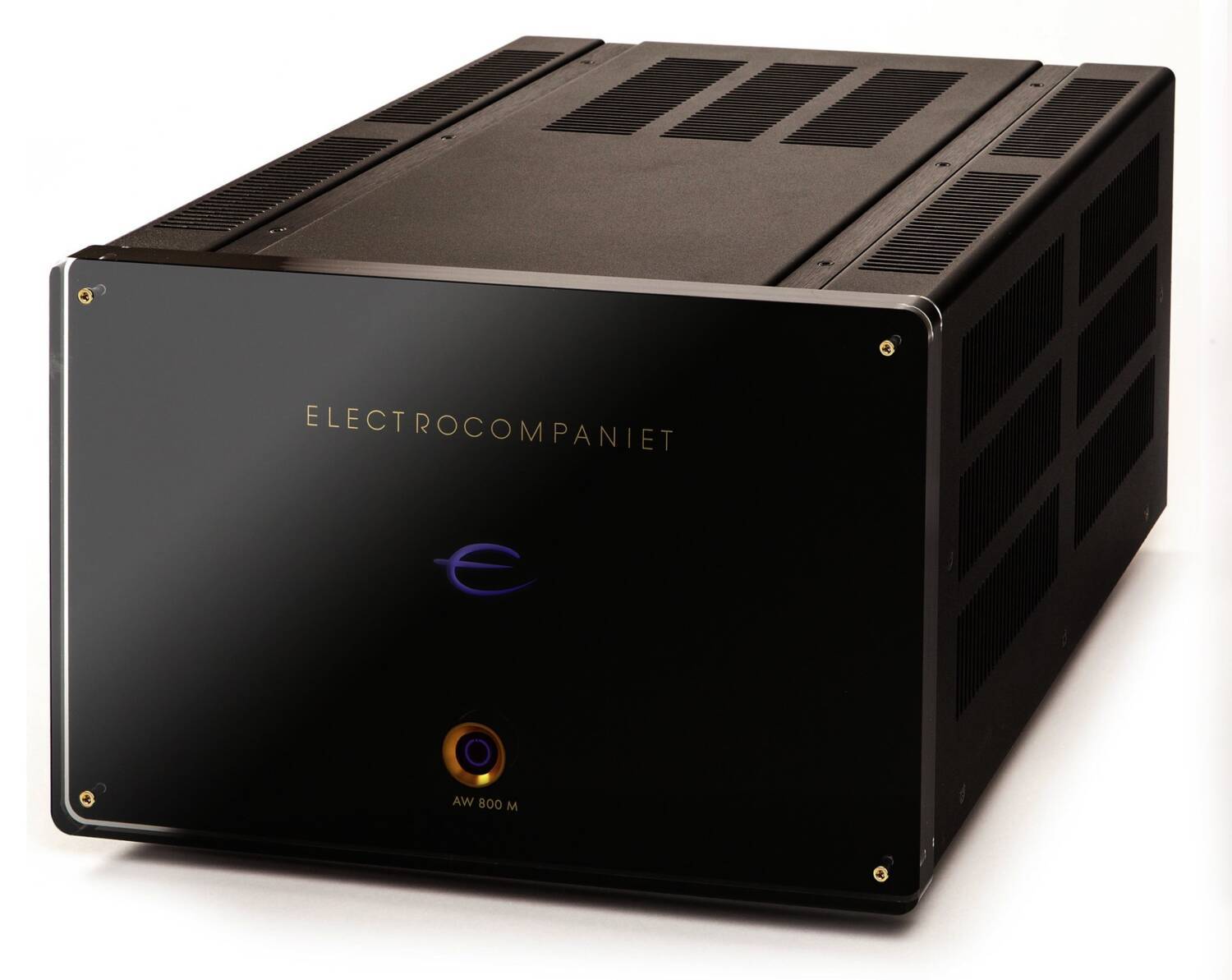Electrocompaniet’s new flagship monoblock/stereo amplifier reviewed. And YES! It has a front power button!
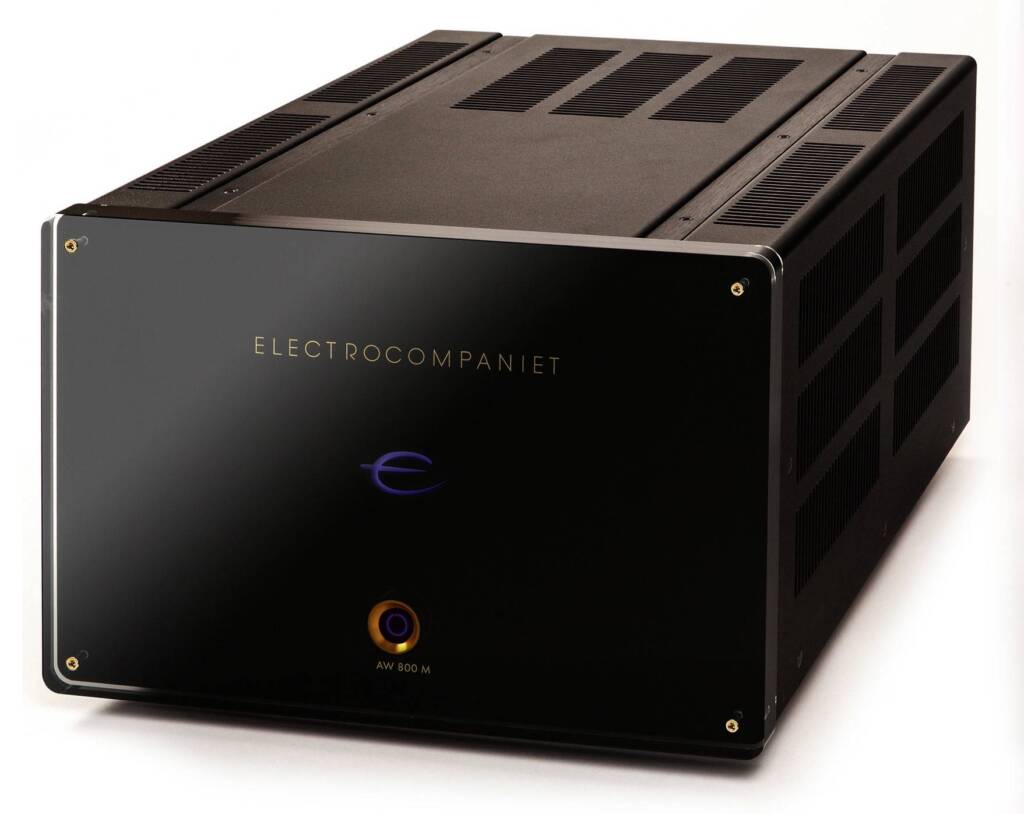
Lets start with the specifications:
TECHNICAL SPECIFICATIONS
| Input impedance: 330 kΩ |
| Frequency resp. (in. filter active):0.5 – 220 kHz |
| Frequency resp. (in. filter dis.): 0.5 – 1.1 MHz |
| Voltage gain (mono, bal. input): 35 dB (x56) |
| Voltage gain (stereo, bal. input): 29 dB (x28) |
| Input-referred noise (20-20kHz): < 2 μV |
| SNR (ref. 1W/8Ω load, 20-20 kHz): 95 dB |
| SNR (ref. full power out, 20-20 kHz): 122 dB |
| Slew-rate (input filter disabled): 270 V/μs |
| DC output voltage: < 5 mV |
| THD+N: 0.0006 % |
| IMD: 0.001 % |
| Damping factor (8Ω load): > 1000 |
| Power consumption standby: < 0.5W |
| Protection: DC, overload, temperature |
| RATED OUTPUT POWER STEREO: |
| 8Ω load: 2 x 300 W |
| 4Ω load: 2 x 600 W |
| 2Ω load: 2 x 1000 W |
| RATED OUTPUT POWER MONO: |
| 8Ω load: 800 W |
| 4Ω load: 1500 W |
| 2Ω load: 2200 W |
| WEIGHT & DIMENSIONS: |
| Weight: 55 kg – 122 lbs |
| Width: 406 mm – 15.98 inches |
| Depth: 488 mm – 19.21 inches |
| Height: 292 mm – 11.49 inches |

POWER AMPLIFIER
RE-DESIGNED
The AW 800 M encompasses the Electrocompaniet direct coupled high open loop bandwidth topology, further enhanced with high slew-rate and very high bandwidth amplifier stages. In addition, a brand-new output stage is designed that heavily shields the input and driver stages from the load and makes the output extremely stiff and unaffected by the connected load. This has the added benefit of significantly simplifying the
workload of the already gently working feedback system and thus provides
vanishingly low distortion figures.
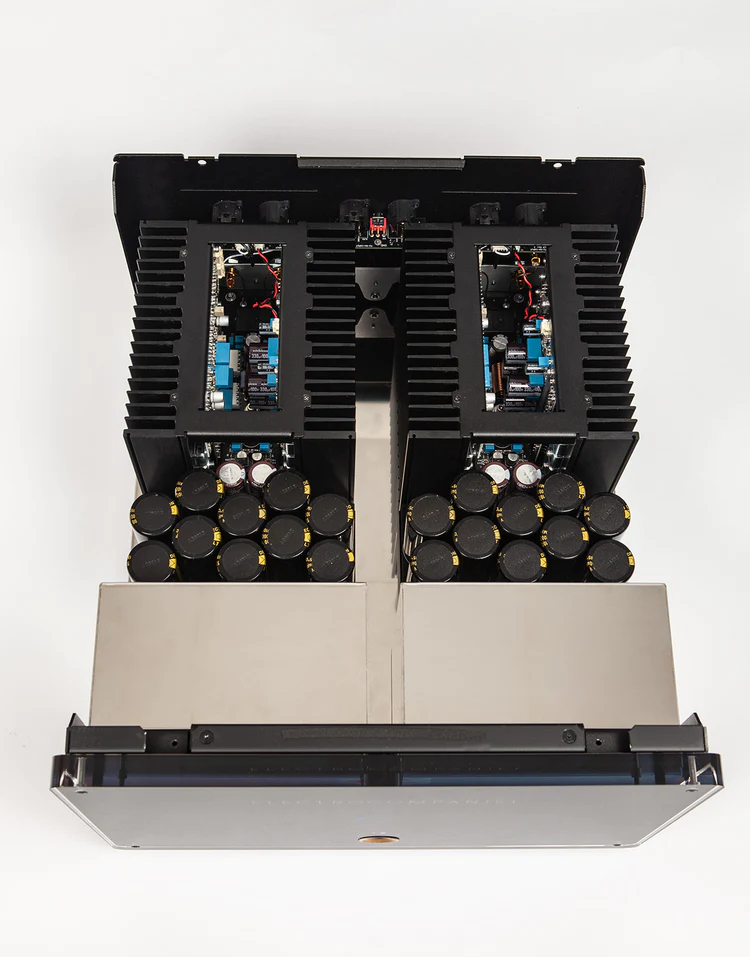
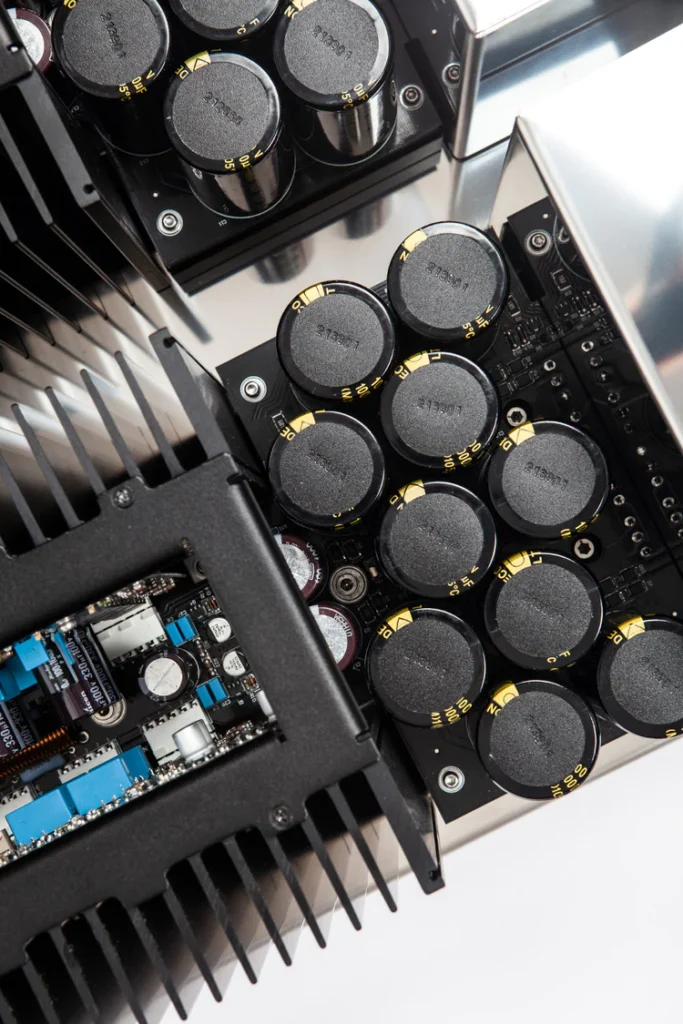
POWER SUPPLY
HEAVILY UPDATED
To feed the output stage the power supply is heavily updated and now has a total of 210000 uF supply filtering.
Mains power input is DC and RF filtered. The twin toroidal, wire gauge upgraded transformers are magnetically and electrostatically shielded to keep any noise from intruding.
The internal ground reference has been vastly over dimensioned and kept fully free of rectifying and output currents. The result is a very clean, noise free output signal regardless of output power, providing a very stable sound stage with the blackest background possible at any sound level.
FUNCTIONAL UPDATES
MONO, STEREO AND BI-AMPING OPERATING MODES
An intriguing new attribute of the AW 800 M is the ability to switch between mono, stereo and bi-amping operating modes, enabling you to upgrade your system or change your configuration while retaining your initial investment. Comfort upgrades are on/off switchable auto power down and switchable feature lighting, user switchable 115/230V mains voltage input as well as trigger input – ouput.
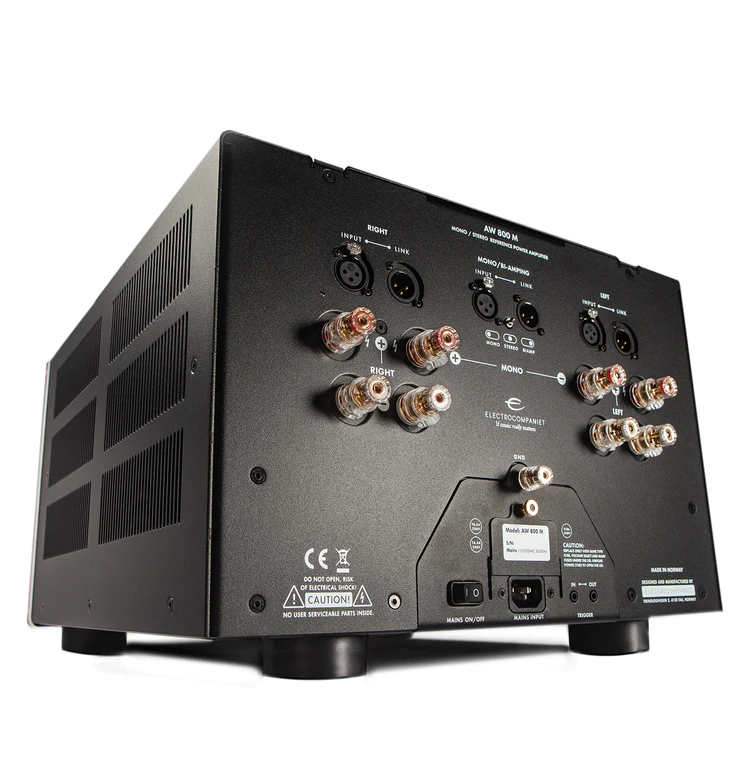
THE REVIEW – 6Moons
https://6moons.com/audioreview_articles/electrocompaniet-nemo800/: The Mighty Electrocompaniet AW800M Amplifier Reviewed!But it’s certainly a season for flagship high-power amps. Kinki Studio’s new 791 monos rate at 600W/4Ω from a quad of 800VA transformers in each amp’s basement coupled to 88’000µF capacitance and 8 pairs of lateral Exicon Mosfets. There’s always the relentless Dan d’Agostino leading this parade with 1.5kW/8Ω, a spec his amp shares with Boulder’s 3050 monos. Once bridged, do our Norse 800-watt Nemo monos claim place? Not on paper. There are kilowatt Goldmund Telos 5500 NextGen monos, kilowatt Bryston 28B³ monos and 900-watt Accustic Arts Mono V. A bit lower on this power perch sit 600-watt 701 monos by Soulution, 600-watt X600.8 monos by Pass, 530-watt Heisenberg monos by Audionet – and others I don’t know of or remember when I keep only lame tabs on hifi’s Hummer heap. No matter how we parse this though, it all makes for quite illustrious company. It’s the global BBC; the Big Boy Club. And today I have a temporary membership card to mix ‘n’ mingle.
UK wall sockets can output either 32A when fed from a ring main or 20A from a radial circuit. Meanwhile UK plugs are fitted with a max 13A fuse to limit a power cord’s fault current during a short circuit. A UK duplex can thus supply 26A total to two appliances fitted with 13A-fused cables drawing their max allowable 3’120 watts (13A x 240V). A standard IEC power inlet like Nemo uses is rated for 15A and not recommended beyond ~70% capacity. When we see amplifier ratings of 50A max thus well in excess of wall current, these are micro-duration peaks provided by capacitive banks acting as virtual batteries or energy storage devices. Nemo combines 0.2 farad capacitance with 32 bipolar output transistors to deliver high instantaneous peak currents. When we consider amplifiers whose wattage ratings seem excessive for our use, we should probably redirect our attention at short-term peak current delivery to restore relevance to what otherwise seems overkill. Musical peaks aren’t that demanding in the higher frequencies but get gnarlier in the bass where larger reactive back-electromotive forces become another factor aside from power draw. From these basics we conclude that, 1/ the benefits of higher power capacitance and current-capable output devices should be most obvious in the bass; 2/ the same benefits should reset crest factor as the decibel difference between average and peak levels.
If anyone brags they possess it for a hifi’s sound months or years later, cough and move on. That said, one aspect of Nemo action triggered instant recall of Ivo Linnenberg’s Georg Friedrich Händel. Those are €23K/pr class A 100-watt monos (400w/2Ω) with advanced switch-mode power supplies. I reviewed them in late 2021. Specs like 1.5MHz bandwidth, 126dB S/NR with 20µV of noise, fully balanced circuity, DC coupled and bipolar output devices trigger more overlap. Sonically it was their memorable blackness of bass which pinged recognition. I’d not heard that before yet here it was again. Coming off my Kinki EX-B7 monos with eight lateral Exicon Mosfets per channel i.e. half of Nemo’s bipolar artillery, this presence was very tacit. A fallback from audiophilia’s lexicon might be authoritative?. Usually inkiness describes a lowered noise floor against which images pop harder for higher contrast. Here it was specific to the low registers. They felt richer, quite like a handful of premium potting soil that’s jet black, moist not dry, airy not clumpy so very other than sand or stone. But the effect’s upshot certainly didn’t limit itself to bass. It caused a wholesale shift into something more present and majestic, innately relaxed yet muscular. Returning to the Black Continent, this wasn’t the twitchiness of a cheetah zigzagging at speed behind a prey. This displayed none of the nervy explosiveness which soon runs out of breath because such effort isn’t sustainable. Neither did it feel like a rampaging rhino’s locomotive mass. It had a far more easeful quality, perhaps like our former wolf hybrids in long-distance ambling mode. Nemo’s power clearly telegraphed no ponderous amorphous massiveness with lost definition. Au contraire. Articulation was on point. As lame as it sounds, blackness really is my best and first term even though I don’t find it particularly encompassing. Sometimes a few words just aren’t enough; or one lacks the right words to begin with.
For more pointers, this change also impacted my perspective on grounding. When someone says that music freely floats between their speakers, we know exactly what they mean. Images hang in space like big soap bubbles, usually at approximately the correct height. I won’t say that here they suddenly stood fully down to their boots as though all difference to live performers had ceased. But I was certainly more conscious of a particular earthing; as though gravity exerted stronger pull. The images didn’t shift in their usual positions relative to the floor. Rather, the ‘ground’ had become another entity or presence I was aware of. The sonic imagery floating over my front wall had a stronger connection to anchored physicality that leaves footprints. Ghosts certainly don’t. In that sense of physical presences extending down to the floor, realism had notched up. I think that’s a fair description of the overall effect or biggest change. More grunt, less float.

Following closely, the second change was dynamic life. With the same comfortable median volume I always use, singers or instruments leaning in for emphasis on a melodic arc or embellishment made their points with grander gestures. Think of normal people encountering a deaf person who must read lips. They suddenly animate their lip movements more to be better legible. I don’t know whether a deaf person would find it so but in my hifi context it certainly was the correct assumption. What imaginative writers call musical message—I prefer microdynamic expressiveness since I haven’t a clue about the artists’ true intentions—was easier to read. After all, as hifi listeners we aren’t deaf but blind. We never see anything other than our familiar room and hardware. It’s all imagination from interpolated aural cues. When those contain more dynamic range, our ‘before’ state invariably feels flatter so more like a telephone autosponder speaking with only marginal inflections. If microdynamics are ripples on a plate that moves up/down with changing average volume, Nemo plated up bigger ripples. And to remain with the autosponder image, those bigger ripples expanded the inflective difference between a more monotonous telephone automaton and real people speaking through lively instruments and song.
Putting this into one paragraph minimized the effect’s true relevance. Just because describing it only took a few sentences doesn’t make it small print we barely read. Just because the prior page predicted as much, this foregone conclusion still made for very happy confirmation in the listening seat. In the sense of emotive expressivity too, realism had notched up. Here that doesn’t mean live music, just easier believability. It’s less stuff our ear/brain must process to accept the hifi illusion. Let’s be very clear. An illusion is all it is. Applying ‘more realism’ to an illusion is very funny business. Our sector is simply used to it. I trust that you appreciate the distinction. The same goes for a side effect. The cheapest trick in any rigged audio comparison is to play whatever we want to win slightly louder so as to not be obvious. But it’ll invariably sound fuller, richer and denser so better. Even though I didn’t play Nemo louder than my Kinki monos, its more padded microdynamics did reach higher so cloned the ‘slightly louder’ benefits of A/B cheating. Going hand in hand was a basic sense of bigger. That actually reflects live music. As sounds get louder, their origins enlarge, too. Scaling up SPL has a parallel track which scales up size. That factored as well. With Nemo, images got slightly larger. À propos large and associated idiocies, turning Nemo on neither temporarily dimmed the lights, caused any pops or stabilizing crackles nor followed some lengthy inner countdown. A fat relay simply turned over, the red power button went blue, the big € logo lit up and voilà; reassuringly normal for such ‘lethal’ specs.

What stepped forward instead was a sense of tones having internal centers or fill. They weren’t hollow. The pits were still in to give an aural equivalent to that delightful resistance one feels when biting into any firm bulging fruit. Surface textures were smooth not slightly suede as class A with 2nd -order THD elements can exhibit. The upper-bass/lower-mid transition felt especially powerful which added gravitas to pull away from any explicit treble. This was back to being more hung than floating. It differed from a number of ultra-bandwidth direct-coupled amps which are more illuminated from the top down thus feel subjectively quicker. This lower center of gravity pooled into the already mentioned quality of relaxed unhurried majesty. It also explained how that blackness in the bass informed the higher ranges; and how that built a rich earthy yet clearly differentiated sound so very easy to love. Even though Nemo contributed to a highly resolved properly mapped and sorted reading, the core impression wasn’t about ‘seeing’ and prioritizing micro-detail inspection. The core impression was rich comfortably dry tonality, potent rhythmic certainty from very developed upper bass and an easefully robust in-room presence of a most materialized sound. That never bared its teeth to bite or blister. Any effects that rely on a tipped-up tonality or more turned-on top end to materialize didn’t come to the fore, be it close-mic’d plucked arpeggios, bowed violin flageolet, hoarse power vocals or crashing cymbals. None of it had Nemo give up any composure whatsoever. Neither did it fall asleep on mellow but saucy fare like this “Gülistan Tango” with its unusual mix of primas violin, cymbalom, bass and Turkish vocals. This would be lovely live music in a typical Vienna coffeehouse, Apfelstrudel far from optional. On matters of weighting between transient, bloom and decay, I thought Nemo perfectly centered. It neither front-loaded the attack nor elongated trailing edges like some single-ended valve amps can. I didn’t hear what I’d think of as dominant 3rd -order THD which gives a more piquant incisive character. Taking note, I realized that I’d subliminally expected its presence to factor. So its absence registered as surprise. It meant that even more trying fare like some of my high-speed Balkan stuff didn’t wear out its welcome; that thinner Azerbaijani studio productions with Korg synths not real pianos were more agreeable to let me enjoy them for their peculiar vocal stylings.
In a perfect world, it’d be summertime always. The cotton would be high, the fish jumping, I rich and handsome. Nemo would be half size, weight and price. Even Raidho’s X2t would have shown up on time. In this world,
I already had more than enough to know Nemo to probably be the best amp I did ever host.
It reset my mind on what many more now bipolar transistors of very high power can do atop the direct-coupled ultra bandwidth I already enjoy. Old Hippocrates’ credo of first to no harm ruled self noise, reflexes and resolution. Those are aspects which this type amp might be expected to harm to ham up its spec fat. Not here. The first watt sounded as good as the 30th . That’s probably what I tapped when things got loud. Rather than view the 270-watt remainder as silly excess sitting idle, I saw a very active current buffer expressing itself clearly at all levels I did use. My less-is-more brain had been steam cleaned of prejudice. I now appreciate the rationale and appeal of massive transistor banks managed immaculately. I even accept the almost certitude that rather than balloon spec fat to hyper porkiness, going dual mono would tack on even more dynamic contrast. Back in the perfect world I’d investigate that next. In this world where backs ache and wallets shrivel like raisins, I don’t have to. I now understand the attendant math. I’m au courant on current and bagging a whale. Please, no one-legged Cap’n Ahab jokes.
HiFi PIG Extract
https://www.hifipig.com/electrocompaniet-aw-800-m-power-amplifiers/: The Mighty Electrocompaniet AW800M Amplifier Reviewed!CONCLUSION
The truth is that I was very excited about these amplifiers arriving for review and my expectations for them was very high. From a review perspective, this is a double-edged sword – will my objectivity be swayed by my excitement or will I be harsher on them because I am expecting too much? As always, I have tried to review these amplifiers as I would any other product that arrives for review and I hope that my enthusiasm for the brand and my previous encounters with their amplifiers have not allowed me to be swayed.
First of all, let me say again that one of these amplifiers will suffice for the vast majority of people. They have the power and control to satisfy even the most demanding of music lovers and deliver the music to your speakers with authority and control across the frequency spectrum – nothing is lacking in this respect. Adding an extra amplifier and running in mono is better and with even more of a feeling of the amplifiers being fully in command of proceedings, but only you can decide whether that increase in performance is worth the extra £19 500. Personally, if I had the money I’d have both, but, equally, I’d be cock-a-hoop with just the one sat betwixt my loudspeakers. For those with the financial ability, by all means buy four and go double mono – and if I had just shy of 80K to spunk on amps, I’d likely go down this route myself.
I’ve thought about this and then I’ve rethought about it again and I have absolutely nothing I can say about these amplifiers that is negative other than I can’t get the speaker posts to accept spades and the dimmer for the light on the front of the amps is way underneath and all but inaccessible. I love the looks, I love their sonic performance…and they don’t even have or need a remote control that I can whine about!
These are the best solid-state amplifiers that I have experienced in our reference system… bar none!

